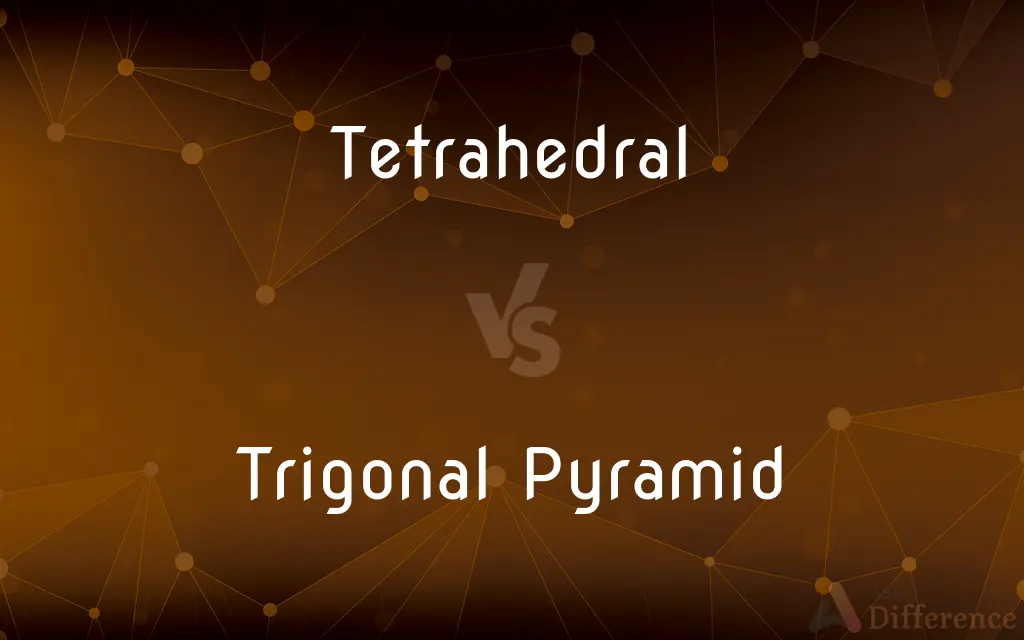Tetrahedral vs. Trigonal Pyramid — What's the Difference?
By Tayyaba Rehman — Published on January 30, 2024
A tetrahedral shape has four faces and four vertices, equally spaced, while a trigonal pyramid has a triangular base and three faces converging to a point above the base.

Difference Between Tetrahedral and Trigonal Pyramid
Table of Contents
ADVERTISEMENT
Key Differences
A tetrahedral structure is a polyhedron with four triangular faces, six edges, and four vertices, with all angles and sides being equal. In contrast, a trigonal pyramid, also a polyhedron, consists of a triangular base and three additional triangular faces that meet at a single vertex above the base, with unequal angles and sides.
In a tetrahedral arrangement, the angles between each face are approximately 109.5 degrees, indicative of equal spatial distribution. Conversely, the trigonal pyramid has a distinct base, and the angles between the base and the other faces are different from those at the apex, leading to a less symmetrical structure.
Molecular geometry often references these shapes: molecules with a tetrahedral geometry have four groups of electrons or atoms around a central atom, evenly spaced. Trigonal pyramidal molecular shapes, however, have three groups and one lone pair of electrons on the central atom, creating a slightly asymmetrical structure.
The tetrahedral shape is commonly seen in molecules like methane (CH4), where the central carbon atom is bonded to four hydrogen atoms at equal distances. In a trigonal pyramidal molecule like ammonia (NH3), the nitrogen atom has three bonded hydrogen atoms and one lone electron pair, causing a pyramidal shape.
Symmetry plays a key role in differentiating these structures. A tetrahedron is highly symmetrical, with all faces being congruent. In contrast, a trigonal pyramid lacks such symmetry due to its distinct base and the positioning of its vertex not being equidistant from all base vertices.
ADVERTISEMENT
Comparison Chart
Faces
Four triangular faces
One triangular base with three triangular faces
Symmetry
Highly symmetrical, all faces and angles equal
Less symmetrical, distinct base and apex
Molecular Example
Methane (CH4)
Ammonia (NH3)
Vertex Count
Four vertices
Four vertices (including base vertices)
Spatial Distribution
Equally spaced around a central point
Asymmetrical due to lone electron pair
Compare with Definitions
Tetrahedral
In geometry, a tetrahedron is a polyhedron with four congruent triangular sides.
A dice in the shape of a tetrahedron has equal likelihood of landing on any face.
Trigonal Pyramid
A trigonal pyramid is less symmetrical compared to a tetrahedron.
In organic chemistry, certain molecular intermediates display a trigonal pyramidal structure.
Tetrahedral
A tetrahedral shape has four equal triangular faces meeting at four vertices.
The methane molecule exhibits a perfect tetrahedral geometry.
Trigonal Pyramid
The base of a trigonal pyramid is distinctly different from its other faces.
The molecular geometry of chlorate ion is an example of a trigonal pyramid.
Tetrahedral
Tetrahedral structures are characterized by 109.5-degree angles between faces.
The arrangement of atoms in a silicon crystal is tetrahedral.
Trigonal Pyramid
A trigonal pyramid consists of a triangular base and three sides converging to a point.
In NH3, nitrogen forms a trigonal pyramidal shape with hydrogen atoms.
Tetrahedral
A tetrahedron is a three-dimensional shape with six equal edges.
Tetrahedral kites maintain stability due to their symmetrical shape.
Trigonal Pyramid
Trigonal pyramids in molecular geometry have three bonds and one lone electron pair.
Phosphorus trichloride (PCl3) is an example of a trigonal pyramidal molecule.
Tetrahedral
Of or relating to a tetrahedron.
Trigonal Pyramid
Trigonal pyramids feature unequal distribution of faces around a central vertex.
The spatial arrangement of ammonia gives it a trigonal pyramidal shape.
Tetrahedral
Having four faces.
Tetrahedral
In the shape of a tetrahedron
Tetrahedral
Having four faces, four apices and six edges
Tetrahedral
Having, or composed of, four sides.
Tetrahedral
Having the form of the regular tetrahedron.
Tetrahedral
Tetrahedral molecules have a central atom surrounded by four other atoms.
In a water molecule, the oxygen atom forms a tetrahedral arrangement with hydrogen atoms and lone pairs.
Common Curiosities
How is a trigonal pyramid different from a tetrahedron?
A trigonal pyramid has a triangular base and three additional faces, while a tetrahedron has four congruent triangular faces.
What is an example of a tetrahedral molecule?
Methane (CH4) is an example of a molecule with a tetrahedral shape.
Are all faces of a tetrahedron identical?
Yes, in a tetrahedron, all four faces are congruent triangles.
Does a trigonal pyramid have a distinct base?
Yes, a trigonal pyramid has a distinct triangular base and three other triangular faces.
Does the trigonal pyramid have symmetrical angles?
No, in a trigonal pyramid, the angles are not completely symmetrical due to the lone pair of electrons.
What are the bond angles in a tetrahedral structure?
The bond angles in a tetrahedral structure are approximately 109.5 degrees.
Is the tetrahedral shape common in crystals?
Yes, many crystals, like silicon, exhibit a tetrahedral arrangement of atoms.
What is the role of lone pairs in trigonal pyramids?
Lone pairs in trigonal pyramids cause asymmetry and affect the molecular shape.
What is a tetrahedral structure?
A tetrahedral structure is a polyhedron with four triangular faces and equal angles between them.
How many vertices does a tetrahedron have?
A tetrahedron has four vertices.
Can trigonal pyramids be found in molecules?
Yes, ammonia (NH3) is an example of a molecule with a trigonal pyramidal shape.
Can a tetrahedron be distorted?
In molecular structures, tetrahedral shapes can be slightly distorted due to bonding differences.
What distinguishes the base of a trigonal pyramid?
The base of a trigonal pyramid is a distinct triangle, different from the other three faces.
Do tetrahedrons and trigonal pyramids appear in organic chemistry?
Yes, both shapes are important in understanding the geometry of organic molecules.
Are trigonal pyramids less symmetrical than tetrahedrons?
Yes, trigonal pyramids are less symmetrical due to their distinct base and apex.
Share Your Discovery

Previous Comparison
Jitter vs. Latency
Next Comparison
Adieu vs. Au RevoirAuthor Spotlight
Written by
Tayyaba RehmanTayyaba Rehman is a distinguished writer, currently serving as a primary contributor to askdifference.com. As a researcher in semantics and etymology, Tayyaba's passion for the complexity of languages and their distinctions has found a perfect home on the platform. Tayyaba delves into the intricacies of language, distinguishing between commonly confused words and phrases, thereby providing clarity for readers worldwide.
















































